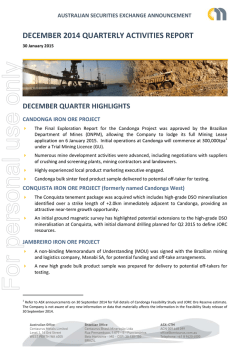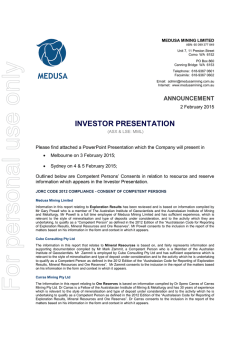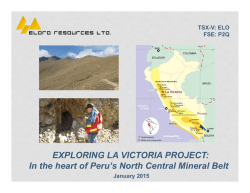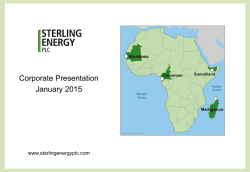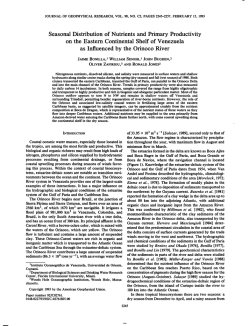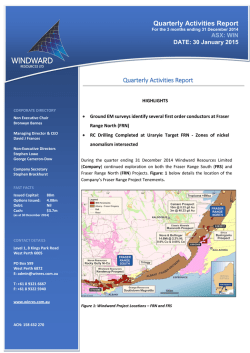
For personal use only - Australian Securities Exchange
For personal use only ASX Release December 2014 Quarterly Report Excellent progress has been made on finalising Project Finance for the Cascavel Project. Orinoco expects to be able to update the market in the coming days with regard to the Financing and the previously announced Share Purchase Plan. Highlights Contact Mark Papendieck Managing Director [email protected] Ground Floor, 16 Ord Street West Perth WA 6005 P (08) 9482 0540 F (08) 9482 0505 Registered Office Outstanding high-grade results and information from the Cascavel exploration decline pave the way for Orinoco to begin planning the Cascavel underground mine and a standalone gravity processing plant to be located at Sertão. Metallurgical testwork indicates gold recoveries of 80-94% from a simple gravity circuit. o CAPEX costings for gravity circuit ~US$5.2M for 12tph name-plate capacity. o 31st January 2015 Ground Floor, 16 Ord Street West Perth WA 6005 PO Box 902, West Perth WA 6872 P (08) 9482 0540 F (08) 9482 0505 [email protected] www.orinocogold.com Capex of ~US$1.4m for underground development (development on vein-set) Latest reported results from continuous sampling within the decline are 15m @ 88g/t Au including o 4m @ 148.5g/t gold (4.7oz/tonne from 18.16m to 22.16m of decline) at approx. 27m from surface and remaining open to the SW o The highest grade panel sample returned to date was 0.5m @ 842g/t (27 oz/tonne from metre 17.34 to 17.72m of decline). Cascavel Mining Lease application was submitted in November 2014 to facilitate expansion from the extraction licence that is currently in place at Cascavel. Cascavel style mineralisation extended to ~4km along strike with addition of new tenement directly north of Cascavel containing known gold mineralisation. Issued Capital 138,507,134 Ordinary Shares 15,000,000 Performance Shares 27,842,756 Listed Options 19,400,000 Unlisted Options ASX Code OGX (Ordinary Shares) OGXO (Listed Options) For personal use only Orinoco details plans for development of its high-grade Cascavel Gold Project, central Brazil. During the quarter, Orinoco Gold Limited reported that, as a result of the continuing outstanding high-grade results and excellent geological information flowing from the exploration decline at its Cascavel Gold Project (OGX 70%) in central Brazil, it has been able to detail a development strategy aimed at bringing a low-cost, standalone mining and processing operation into production as soon as suitable funding has been secured. The development strategy is based on independently establishing an initial ~40,000tpa (12 tonnes per hour) gravity circuit, currently planned to be located on the Company’s existing Mining Lease at the nearby Sertão Gold Mine, ~28km by road, and processing high-grade ore from Cascavel. Orinoco is now well placed to make the all-important transition from explorer to producer once Project Finance is sourced, and to pursue its longer-term goal of growing a high-grade resource inventory and developing a substantial gold production centre within its broader Faina Goldfields Project in the State of Goiás in central Brazil. NOTE: No specific gold production targets for Cascavel can currently be quoted as Cascavel does not have a resource statement completed in compliance with the JORC 2012 code. This is due to the very coarse nature of the gold at Cascavel making it difficult to estimate through drilling (see below). Bonanza gold grades and excellent structural information from the Cascavel decline give the Company confidence to commence development without JORC compliant resource definition. The outstanding results flowing from the exploration decline during the second half of 2014 have given the Company sufficient information and confidence in the geology of the mineralisation at Cascavel to conclude that an underground mine feeding a simple gravity gold extraction plant located nearby is the most efficient way to unlock the value of the deposit in the short-term. The most recent assay results have extended this high-grade contiguous zone to 15m at an average grade of 88g/t Au. While the coarse nature of the gold offers many advantages in terms of low-cost processing and recovery, it does make the task of resource estimation within the JORC code prohibitively expensive. This is due to the very coarse nature of the gold (80% > 100microns) and the small volume of sample that can be collected through diamond drilling (approximately 8kg/m HQ core). Drilling provides a highly effective measure of the geological continuity of the Cascavel system but is not particularly useful for grade estimation in such high-grade, coarse gold systems. Given the difficulty and expense of defining JORC compliant resources through drilling in systems such as Cascavel the Company is of the view that establishing a low-cost gold operation is the best way to create shareholder value. Initial mine plan to focus on small portion of Cascavel and Mestre areas - ~120m x 250m The initial mine plan will encompass only a small portion of the Cascavel and Mestre areas, where limited historical mining and the Company’s exploration decline has opened up access to high grade shoots Figure 1. Importantly, this area has been well tested by diamond drilling and also contains the current Cascavel exploration decline, which enables accurate location of the For personal use only vein system (figure 1). Bulk sampling and the ongoing exploration decline at Cascavel have shown that most of the gold mineralisation at Cascavel is contained in high-grade gold shoots (e.g. 15m @ 88g/t gold – see ASX Announcement, 21/10/14). Other bulk samples from the Cuca winze (350m north) and the nearby Mestre winze (90m south) have recorded grades of 27g/t (2.8tonnes) and 39g/t (500kgs) gold respectively. Drilling and sampling along strike from Cascavel indicates that the gold-bearing structures have considerable continuity, with the structurally controlled gold mineralisation shown to be occurring at multiple points over more than 4km immediately along strike from Cascavel. The same generation of mineralised shear zones continue 18km to the South where they host the ore at the Sertão Gold Mine (Previously operated by Troy Resources but now 100% owned by OGX). The shear zones have similar features at each locality where a central quartz ± carbonate veinset is found within a well-developed muscovite – biotite alteration envelope. Importantly the high-grade gold shoots in each location are developed parallel to a very strong penetrative mineral stretching lineation spatially related to these shear zones. Similarly, the down-plunge continuity of the gold-bearing structures has been demonstrated in drilling at both Cascavel and Sertão to over 600m down-dip – and remains open. Regionally, this high level of continuity is a common feature of the shear zone hosted gold deposits in the State, with both Anglo Gold Ashanti and Yamana Gold having multi-million ounce resources in similar structures. The evidence for mineralisation in and around the Cascavel area gives the Company great confidence that it can rapidly grow the potential of the Faina Goldfields Project. Figure 1. Showing a plan view of the intial area of underground mining In the Cascavel area. For personal use only Metallurgical test work indicates gold recoveries of between 80 - 94% from a simple gravity circuit - CAPEX costings for gravity plant with name plate capacity of 40kt/annum and mine establishment estimated at US$6.6m The total plant and equipment component for the contemplated 40,000tpa operation is estimated at US$5.2 million for a gravity-only operation and contains no long lead items. The total capital cost for the installed and commissioned gravity circuit and the mine development is estimated at US$6.6m. The low capital cost is largely attributable to the fact that gold recoveries of more than 80 per cent (and up to 94%) have been achieved in metallurgical testing from Cascavel ore using a simple gravity circuit with no cyanide involved. The Company is currently in discussions with several parties regarding appropriate funding options for the financing of the Project, and will shortly be in a position to commence ordering equipment subject to securing a suitable funding package. Project timings will be able to be provided at the completion of the appropriate funding, however it is anticipated to take approximately seven months from the ordering of locally sourced equipment to install and commission the gravity circuit. From a mining perspective, development is able to commence immediately upon securing funding. The Company’s current extraction permit allows underground mining activities, enabling it to proceed with underground mine development at any point The proposed development pathway will utilise the Company’s existing underground extraction licence at Cascavel to selectively mine the currently identified high-grade shoots. Installation of plant and equipment at Sertão is able to commence at any point, and administrative work is currently being completed to return the environmental & mining licences at the Sertão Gold Mine to operational status. Cascavel Mining Lease application to be submitted in November 2014 to facilitate future open pit mining An application for a full Mining Lease at Cascavel was lodged in November 2014. The Cascavel Mining Lease application will include plans for the installation at Cascavel of a larger capacity gravity circuit with an associated CIL circuit which metallurgical testing has shown should allow recovery of over 98 per cent of the gold in ore at Cascavel. For personal use only Figures 2a and 2b – Show coarse visible gold up to 5mm strongly elongated parallel to the stretching lineation. For personal use only Figure 3. Cleaning the face of the exploration decline ahead of sampling. Figure 4. Panning of a sample from Cascavel CASCAVEL GROWS During the quarter, Orinoco announced that it has materially increased the size of its high-grade 70%-owned Cascavel Gold Project in central Brazil after securing a highly prospective nearby tenement with known gold mineralization (The Garimpo target). The Cascavel partnership was the successful bidder for the tenement, which is situated immediately to the north of both the Cascavel gold and the Central Tinteiro polymetallic Projects (see Figure 7). For personal use only The new tenement contains significant north-west extensions of both the Cascavel and Tinteiro geological trends, extending the known Cascavel structure by 60% to approximately 4km of strike. Significantly, the tenement contains a well-known “Garimpo” (artisanal mine) that produced gold from approximately 2010-2012, when Orinoco’s 30% partner at Cascavel purchased the farm-land and removed the artisanal miners. The previous artisanal mining activities targeted gold mineralisation hosted by a low angle thrust fault immediately above and parallel to the structures that host the mineralisation at Cascavel and Orinoco’s 100%-owned Sertão gold project. The artisanal workings are located approximately 1.5km further north-west along strike from the most northerly results reported previously by Orinoco where a 2.5-tonne bulk sample from the Cuca winze returned an average grade of 27.2 g/t gold. The artisanal workings consist of a series of winzes developed along approximately 200m of strike. As with Cascavel, the mineralised horizon is composed of a set of quartz veins and associated biotite alteration halo, which also carries gold grades. A limited chip sampling program was conducted over the mineralised horizon with positive gold grades in all samples and 9 of the 10 samples returning grades of over 1g/t of gold, with a maximum result of 9.9 g/t of gold (see Table 1). The addition of this tenement not only significantly extends the strike of the Cascavel structure and confirms the repetition of mineralised horizons almost 1.4km to the north-west but also highlights the prospectivity of the shear zones along (and beyond) the underexplored 20km long Sertão – Cascavel corridor. The new tenement will now become an Exploration Application prior to being gazetted as an Exploration Lease. No payment for the tenement (other than the usual Department of Mines annual fees) is required and the Exploration Lease will form part of Orinoco’s 70:30 partnership at Cascavel. For personal use only Figure 5- Outcropping mineralised zone at the Garimpo target, 1.5kms from Cascavel FAINA GOLDFIELDS For personal use only Eliseu Detail map contour Cascavel and Tinteiro Sertão 50 km OGX new Tenement area SHALLOW SW DIPPING SHEAR ZONES THAT HOSTS CASCAVEL/SERTÃO STYLE GOLD MINERALIZATION (RED LINE) 1,400 metres OGX Cascavel Tenement OGX Tinteiro Tenement OGX Cascavel/Tinteiro Tenement Figure 6- Geological Map of the new Tenement in relation to the Cascavel and Tinteiro Targets. For personal use only Corporate During the quarter Orinoco raised $1.1M through a share placement to new and existing sophisticated and professional investors comprising 16.1M shares at an issue price of $0.07 per share, representing 13% of the Company’s issued capital, with a free attaching option, exercisable at 11 cents (with an 18 month term), to be issued on a 1-for-1 basis subject to shareholder approval to be sought in the first quarter of 2015. -ENDSFor further information, please contact: Mark Papendieck Managing Director Orinoco Gold Limited 08 9463 3241 [email protected] Nicholas Read Managing Director Read Corporate 08 9388 1474 0419 929 046 Competent Person’s Statement: The information in this presentation that relates to Exploration Results is based on information compiled by Dr Klaus Petersen who is a member of the Australasian Institute of Mining and Metallurgy and CREA. Dr Klaus Petersen is an employee of Orinoco Gold Limited and has sufficient experience, which is relevant to the style of mineralisation under consideration and to the activity that they are undertaking to qualify as a Competent Person as defined in the 20012 Edition of the Australasian Code for Reporting of Exploration Results, Mineral Resources and Ore Reserves. Dr Klaus Petersen and Dr. Marcelo Juliano de Carvalho consent to the inclusion in this report of the matters based on the information in the form and context in which it appears. Previous Reported Results: There is information in this report relating to Exploration Results at Cascavel. Full details of the Results were included in the following ASX Release and are available to view on the Company’s website www.orinocogold.com: 1. 2. 3. 4. 5. 6. 7. 8. 7 July 2014 – Bonanza Gold Results up to 27 oz/tonne from Cascavel Exploration Decline 14 May 2014 - Outstanding Gold Grade from Latest Cascavel Bulk Sample 30 May 2014 - Orinoco to Drill Test Significant New Tinteiro IOCG Targets 8 May 2013 – Thick High Grade Silver Discovered at Cascavel 23 December 2013 – Clarification to Inside Briefing Interview Announcement 20 January 2014 - Successful Bulk Sampling Highlights the Opportunity for High Grade Development at Cascavel Gold Project. 8 October 2012 - High-Grade Gold Results Returned From Curral De Pedra Project, Brazil 12 December 2012 - Hits of up to 193gpt Au confirm mineralisation over 620m down dip The Company confirms that it is not aware of any new information or data that materially affects the information included in the original market announcements and that all material assumptions and technical parameters underpinning the Exploration Results in the relevant market announcement continue to apply and have not materially changed. The Company confirms that the form and context in which the Competent Person’s findings are presented have not been materially modified from the original market announcement. Forward-Looking Statements: This Announcement includes “forward-looking statements” as that term within the meaning of securities laws of applicable jurisdictions. Forward-looking statements involve known and unknown risks, uncertainties and other factors that are in some cases beyond Orinoco Gold Limited’s control. These forward-looking statements include, but are not limited to, all statements other than statements of historical facts contained in this presentation, including, without limitation, those regarding Orinoco Gold Limited’s future expectations. Readers can identify forward-looking statements by terminology such as “aim,” “anticipate,” “assume,” “believe,” “continue,” “could,” “estimate,” “expect,” “forecast,” “intend,” “may,” “plan,” “potential,” “predict,” “project,” “risk,” “should,” “will” or “would” and other similar expressions. Risks, uncertainties and other factors may cause Orinoco Gold Limited’s actual results, performance, production or achievements to differ materially from those expressed or implied by the forward-looking statements (and from past results, performance or achievements). These factors include, but are not limited to, the failure to complete and commission the mine facilities, processing plant and related infrastructure in the time frame and within estimated costs currently planned; variations in global demand and price for coal and base metal materials; fluctuations in exchange rates between the U.S. Dollar, the Brazilian Real and the Australian dollar; the failure of Orinoco Gold Limited’s suppliers, service providers and partners to fulfil their obligations under construction, supply and other agreements; unforeseen geological, physical or meteorological conditions, natural disasters or cyclones; changes in the regulatory environment, industrial disputes, labour shortages, political and other factors; the inability to obtain additional financing, if required, on commercially suitable terms; and global and regional economic conditions. Readers are cautioned not to place undue reliance on forward-looking statements. The information concerning possible production in this announcement is not intended to be a forecast. They are internally generated goals set by the board of directors of Orinoco Gold Limited. The ability of the company to achieve any targets will be largely determined by the company’s ability to secure adequate funding, implement mining plans, resolve logistical issues associated with mining and enter into any necessary off take arrangements with reputable third parties. Although Orinoco Gold Limited believes that its expectations reflected in these forward-looking statements are reasonable, such statements involve risks and uncertainties and no assurance can be given that actual results will be consistent with these forward-looking statements. It is common practice for a company to comment on and discuss its exploration in terms of target size and type. Any information relating to the exploration target should not be misunderstood or misconstrued as an estimate of Mineral Resources or Ore Reserves. Hence the terms Resource(s) or Reserve(s) have not been used in this context. The potential quantity and grade is conceptual in nature, since there has been insufficient exploration to define a Mineral Resource. It is uncertain if further exploration will result in the determination of a Mineral Resource Section 1 Sampling Techniques and Data For personal use only Criteria Sampling techniques Commentary Continuous panel sampling has been undertaken across the mineralised zone at Cascavel. Panels measuring approximately 0.5m x 0.5m are being cut contiguously (each panel abutting another panel) along both walls of the decline with the sample from each panel being composed of chips from the entire area of each panel. The panel samples in the current exploration decline represent a section sub-parallel to the strike and almost perpendicular to the dip (the decline cross-cuts sections of the high-grade shoots that dip to the SW). Where a vertical height of more than 0.5m is assessed as requiring sampling, contiguous panels will be cut below or above a panel. Each panel sample (approximately 4-11kg in weight) is crushed/milled/homogenised and split to obtain a 1kg sample in the laboratory and that 1kg sample is submitted for a screen fire assay. Panel sampling has been undertaken along the mineralised vein/s and alteration and screen fire assay has been used to obtain correct grades of each panel. This assay procedure is not only more expensive but needs more time for the lab to screen larger amounts of the samples instead of splitting fractions in an ordinary fire assay procedure. Channel sampling on the entire height of the exploration decline has been done every three metres to maintain control on the potential mineralisation of the hostrock (not visually recognisable) All data is stored in the database following appropriate QA/QC procedures. Drilling techniques No drilling is reported in this announcement. Drill sample recovery No drilling is reported in this announcement. Logging All samples reported in this announcement were logged by a qualified geologist and recorded in the Company’s database. Sub-sampling techniques and sample preparation Panel samples are sent to the laboratory without drying or splitting. Blanks and standards are inserted into panel samples batches; In the lab, all samples are dried at 100°C and crushed to 9 mesh in a jaw crusher. The samples go to a Jones or Rotary splitter and 500g of material is separated and powdered to 150 mesh. The 150# pulp is quartered and an aliquot of 50g is obtained. This aliquot is analysed by Fire Assay in non-mineralised samples. Metallic Screen Fire Assay is applied if the sample is considered mineralised. Selective samples are analysed in ICP-MS (Inductively Coupled Plasma Atomic Emission Spectrophotometry), with a multi-acid digestion for 32 elements. Quality of assay data and laboratory tests All results received from laboratories are recorded in Orinoco’s QA/QC database, and the results referred to in this announcement are deemed to be within an acceptable band (see below Verification of sampling and assaying) Verification of sampling and assaying Standards: (insertion of different standards in each 30 samples approximately): If less than 10% are outside of the mean + 2x Std. Dev, the results are validated. If less than 10% is outside the Mean + 3x Std. Dev, but there are standards between the first and these two points - the results are validated, but the Lab is notified. If For personal use only Criteria Commentary more than 10% is outside the Mean + 3x Std. Dev, the batch (40 samples) is rejected, an investigation is required and a re-analysis of the batch is made; Blanks (insertion in each 30 samples approximately): If less than 5% are above 5x the detection limit of the Lab, the results are validated. If more than 5% is above 5x the detection limit, the Lab is notified and the batches with failure are reanalysed; Duplicates (insertion in each 20 samples – Bias control): Project Duplicates are core quarter and Lab duplicates are Gravel and Pulp Duplicates. Location of data points The topographic survey on the exploration decline has been done with the help of a Total Station (RUIDE), model RTS 822R³. The survey use prisms for the coordinate transport (UTM) and laser for the location of channels, panels and decline walls and decline sections. The grid system used is UTM South American 1969 - Zone 22 S; The topography crew uses local landmarks to guarantee the quality of their surveying. Data spacing and distribution Panel samples are approximately 0.5 x 0.5 metres and continuous on the mineralised zone. Orientation of data in relation to geological structure The data orientation is intended to cover the mineralised zone approximately along strike and down dip. Sample security Samples are stored in plastic sample bags, stored in the core shed on site prior to transport to the lab. All laboratory pulps are stored in the core shed in boxes supplied by the labs, stacked in dry places. Audits or reviews No audit or review has been undertaken regarding the results reported in this announcement. Section 2 Reporting of Exploration Results (Criteria listed in the preceding section also apply to this section.) Criteria Commentary Mineral tenement and land tenure status The Faina Goldfield project is 70% owned by Orinoco do Brasil Mineração Ltda, which in turn is 100% owned by Orinoco Gold Ltd. The 30% partners are free carried during the exploration stage until a decision to mine. The Sertão and Antena mining leases are owned 100% by Orinoco. Some locations within the Cascavel project have archaeological sites that are required to be mapped and photographed prior to removal of the sites. The key Tinteiro tenements are granted exploration leases. The key Cascavel tenement has a granted trial mining licence for 50.000 tonnes ROM for underground operation and granted Environmental/Archaeological licences. Exploration done by other parties Exploration for oxide gold deposits has been well developed through the belt during the last 20 years, in different cycles and by different companies. Initial exploration according to IOCG models is recorded to have taken place in recent times. A For personal use only Criteria Commentary reasonable amount of surface exploration has been carried out. Soil, stream sediments and chip sampling (for gold) are widespread along and around both belts. Those surface surveys detected several gold and arsenic anomalies (about 64 anomalies are described). Some of those anomalies were tested with drilling, frequently with positive results. However drilling was generally very shallow RAB drilling. Geology CASCAVEL: Cascavel is best characterised as an Archean shear hosted Orogenic gold system. The structurally controlled mineralised quartz vein/s, veinlets and related sericite alteration evident in the decline and from drilling are continuous both along strike and down-plunge with some minor off-sets caused by later E-W and N-W striking faults (associated with the Tinteiro mineralisation). Visible offsets are no greater than 1m in the walls of the decline. These late faults also cause a slight rotation between the blocks, slightly changing the dip of the veins. Repetition of high grade shoots along the strike has been confirmed by bulk and panel sampling and with visible gold up to 10mm in size evident in the walls of the decline. REGIONAL: Gold mineralisation is widely distributed on the Faina Greenstone Belt, occurring in the ultramafics, felsic and mafic volcanics, in the clastic metasedimentary sequence and particularly in the chemical metasedimentary rocks; Strong gold anomalies seem to be very continuous also along the strike, mostly associated with the main regional scale shear zones; Mineralisation style is also varied on the belt. Most of the gold mineralisation can be classified as Orogenic, mainly hosted in chemical and volcanoclastic sedimentary units. The following models are considered relevant: Shear Hosted (Orogenic) associated with carbonaceous/BIF hosts, mafic volcanic and volcanoclastic units. Paleo-Placer/Conglomerate Hosted: associated with meta-conglomerates within the Proterozoic (Paleo?) transgressive clastic sequence. Au rich VHMS: hosted by younger Meso-Proterozoic intrusives in the volcanosedimentary rocks sequence in the Goiás Block, potentially in the Faina greenstone. The silver-tungsten-copper mineralisation at Cascavel has been interpreted as a carbonate replacement deposit due to the strong relationship to the impure limestone unit and crosscutting faults. Tinteiro Target shows features so far interpreted as being related to an IOCG system. Polymetallic mineralisation at Tinteiro: silver/tungsten/copper is interpreted as a carbonate replacement mineralisation type that overlaps parts of the Cascavel Orogenic style mineralisation and represents a distal expression of the Tinteiro system. Closer to the core of the Tinteiro system gold, copper, barium, cobalt, uranium anomalies occur with hematite, potassic and sodic alteration together with structural features like fold hinges and crosscutting faults that are interpreted as an IOCG target. The mineralisation of copper/gold/silver and other metals at Tinteiro is associated with zones of mainly hydrothermal sericite, hematite and magnetite alteration that are associated with regional and potentially deep crustal faults systems showing several non-deformed mafic alkaline to felsic intrusions. These mineralised faults have been mapped and sampled over an area of approximately 7km x 4km to date. Drill hole Information No drill holes are reported in this announcement. For personal use only Criteria Commentary Data aggregation methods To composite the panel samples the results where treated as a drill core section. The Relationship between mineralisation widths and intercept lengths Reported rock chips are single point, selective samples of outcropping lithologies. Diagrams Diagrams are attached to the current announcement. Balanced reporting This announcement is a comprehensive report of the results covered by this announcement. Other substantive exploration data Only assays for panel samples are reported in this announcement. Further work Drilling and exploration decline development is required to test the identified targets at depth. coordinates of the middle point at the left edge of each panel and vector data of azimuth and dip angles of a middle line in the panels was precisely surveyed. Those lines were used for the from/to data on the assay table. To give the correct weight for the grades in the panels due to minor differences in the length, 0.5 metres was considered 100% and all grades went normalised to this length. The normalised intervals where used to obtain the composite grade for the section. Interests in Mining Tenements: For personal use only Project/Tenements Type of Tenement Cascavel 860.167/2007 860.480/2009 861.586/2009 860.185/2011 861.796/2007 Faina Regional / Tinteiro 860.284/2010 860.968/2010 860.434/2010 860.435/2010 861.288/2009 860.436/2010 861.277/2010 860.600/2011 862.520/2011 860.185/2012 861.347/2012 860.157/2013 860.051/2012 860.188/2012 860.856/2012 860.404/2013 860.863/2006 861.340/2008 861.590/2009 861.341/2008 861.229/2005 861.258/2003 861.445/2010 860.336/1990 860.337/1990 861.796/2007 861.918/2013 861.917/2013 860.699/2013 Extraction Licence and Mining Lease Application Exploration Exploration Exploration Tender Application Exploration Exploration Exploration Exploration Exploration/ Application for Extension Exploration / Application for Extension Exploration Exploration Exploration Exploration Exploration Exploration Exploration Application Exploration Application Exploration Application Exploration Tender Application Tender Application Tender Application Tender Application Tender Application Tender Application Tender Application Tender Application Tender Application Tender Application Exploration Application Exploration Application Exploration Sertão 860.368/1995 860.096/1986 760.742/1996 Mining Lease Mining Lease Mining Lease Application Location Faina Brazil Held at end of Quarter Acquired during the quarter Disposed of during the quarter 70% - - 70% 70% 70% 70% 70% - * * * * * - - * - - 70% 70% * * * * 70% 70% 70% 70% * * * * * * * 70% 70% 70% 70% 70% * - - 100% 100% 100% - - Faina Brazil Faina Brazil Interests in Farm-in/Farm-out agreements: For those tenements above marked with an *, Orinoco is farming in to the tenements to earn 60% through exploration over 30 months and making milestone payments after 18 and 30 months. An additional 15% can be purchased by Orinoco at an agreed rate based upon agreed metrics.
© Copyright 2026
